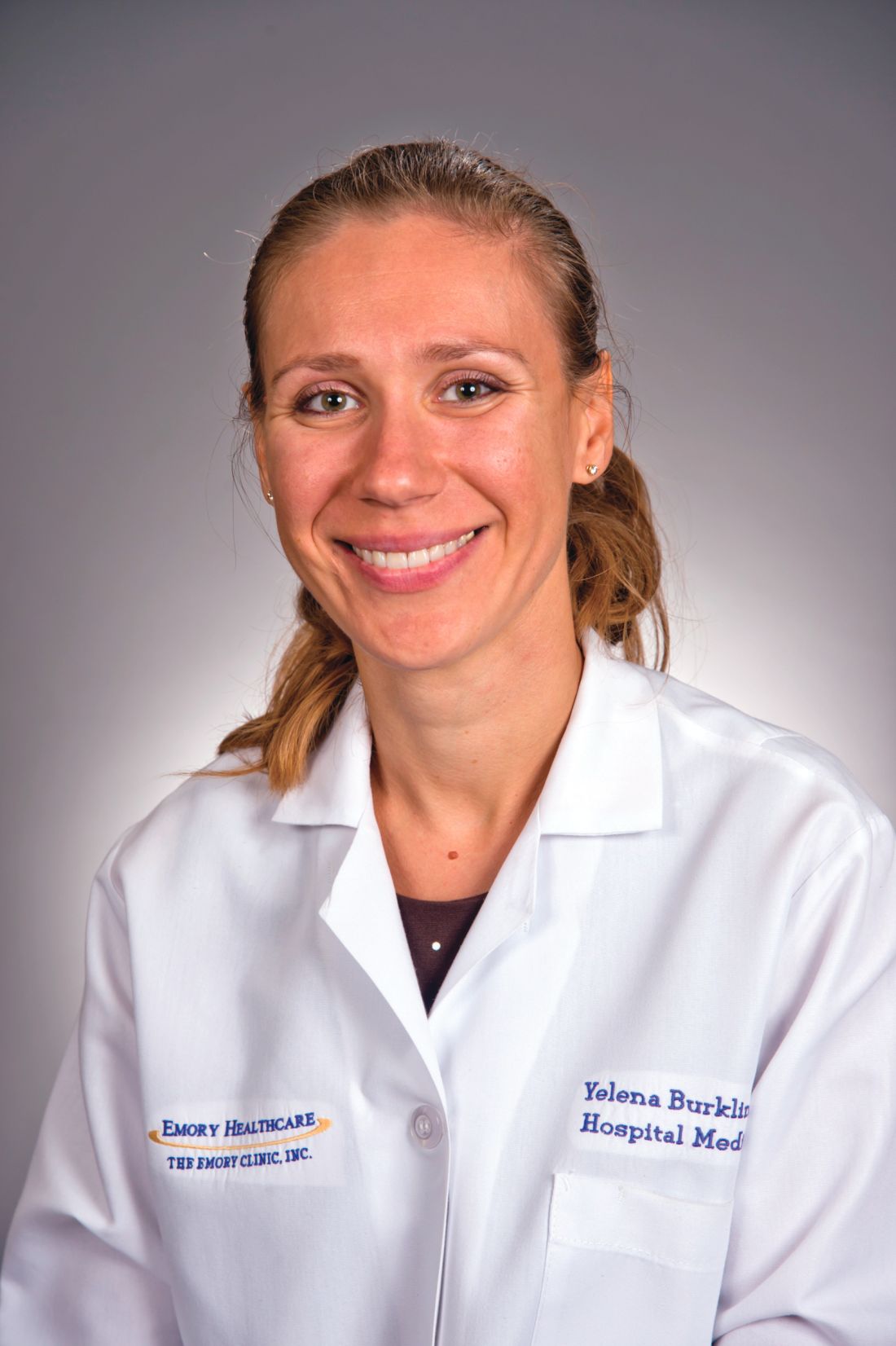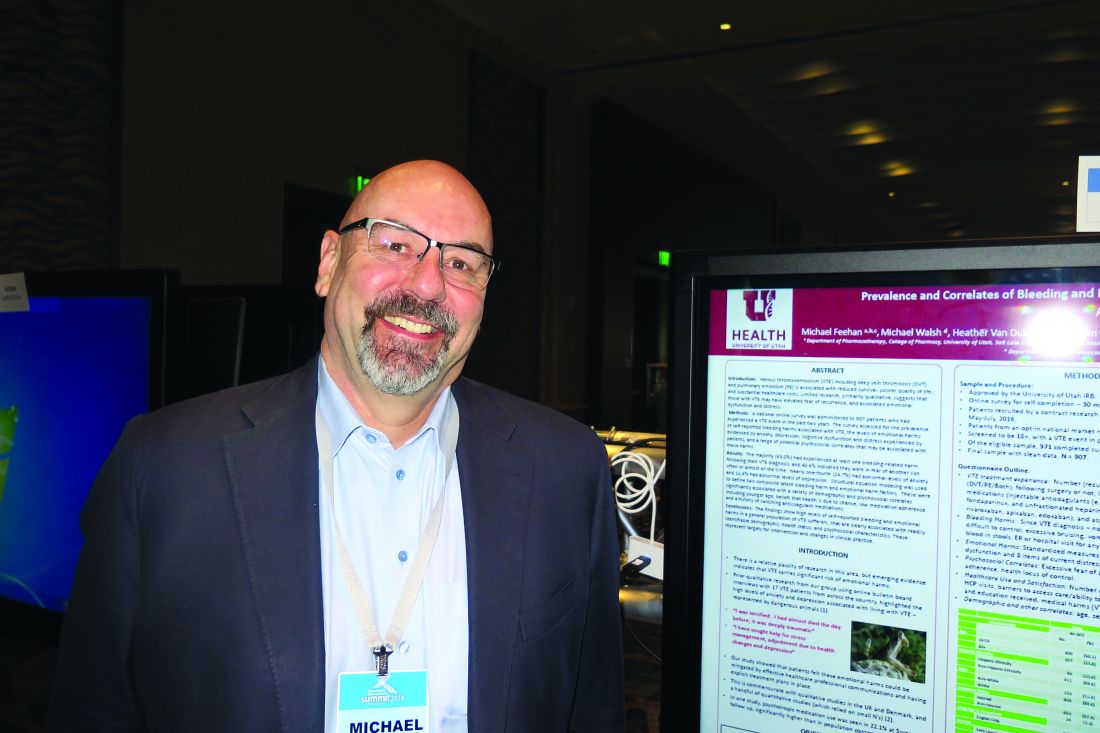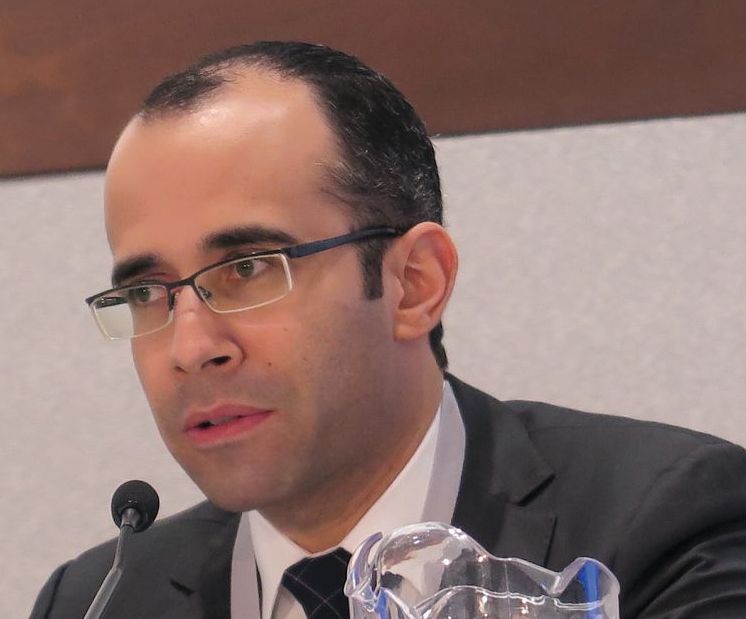User login
Any detectable high-sensitivity cardiac troponin T (hs-cTn) level is associated with adverse outcomes
Clinical question: What is the association between high-sensitivity cardiac troponin T (hs-cTn) levels and outcomes in patients with chest pain?
Background: There are few data on the link between hs-cTn levels and outcomes in patients with chest pain but no myocardial infarction or any other condition that can cause acute increases in troponin levels.
Study design: Observational cohort study.
Setting: Patients older than 25 years old with chest pain presenting to the emergency department at a university hospital in Sweden.
Synopsis: 19,460 patients with chest pain who had at least one hs-cTn level obtained during their ED visit were included in this study. In comparison with patients who had hs-cTn less than 5 ng/L, the adjusted hazard ratios for all-cause mortality were 2.00, 2.92, 4.07, 6.77, and 9.68, in patients with hs-cTn levels of 5-9, 10-14, 15-29, 30-49, and 50 or greater ng/L, respectively. The yearly rates of MI were 0.3% and 4.5% in patients with hs-cTn levels less than 5 ng/L and 50 or greater ng/L, respectively. The yearly rates of hospitalization for heart failure were 0.1%, 1%, 2.8%, and 20% in patients with hs-cTn levels less than 5, 5-9, 10-14, and 50 or greater ng/L, respectively. There was a clear and graded association between any detectable levels of hs-cTn and risk factors for cardiovascular and noncardiovascular mortality, MI, and heart failure.
Bottom line: For patients with chest pain and stable troponin levels, there is an elevated risk of death, hospitalization for heart failure, and MI, if there is any detectable level of hs-cTn.
Citation: Roos A et al. Stable high-sensitivity cardiac troponin T levels and outcomes in patients with chest pain. J Am Coll Cardiol. 2017 Oct 31;70(18):2226-36. doi: 10.1016/j.jacc.2017.08.064.
Dr. Clarke is assistant professor of medicine in the division of hospital medicine, Emory University, Atlanta.
Clinical question: What is the association between high-sensitivity cardiac troponin T (hs-cTn) levels and outcomes in patients with chest pain?
Background: There are few data on the link between hs-cTn levels and outcomes in patients with chest pain but no myocardial infarction or any other condition that can cause acute increases in troponin levels.
Study design: Observational cohort study.
Setting: Patients older than 25 years old with chest pain presenting to the emergency department at a university hospital in Sweden.
Synopsis: 19,460 patients with chest pain who had at least one hs-cTn level obtained during their ED visit were included in this study. In comparison with patients who had hs-cTn less than 5 ng/L, the adjusted hazard ratios for all-cause mortality were 2.00, 2.92, 4.07, 6.77, and 9.68, in patients with hs-cTn levels of 5-9, 10-14, 15-29, 30-49, and 50 or greater ng/L, respectively. The yearly rates of MI were 0.3% and 4.5% in patients with hs-cTn levels less than 5 ng/L and 50 or greater ng/L, respectively. The yearly rates of hospitalization for heart failure were 0.1%, 1%, 2.8%, and 20% in patients with hs-cTn levels less than 5, 5-9, 10-14, and 50 or greater ng/L, respectively. There was a clear and graded association between any detectable levels of hs-cTn and risk factors for cardiovascular and noncardiovascular mortality, MI, and heart failure.
Bottom line: For patients with chest pain and stable troponin levels, there is an elevated risk of death, hospitalization for heart failure, and MI, if there is any detectable level of hs-cTn.
Citation: Roos A et al. Stable high-sensitivity cardiac troponin T levels and outcomes in patients with chest pain. J Am Coll Cardiol. 2017 Oct 31;70(18):2226-36. doi: 10.1016/j.jacc.2017.08.064.
Dr. Clarke is assistant professor of medicine in the division of hospital medicine, Emory University, Atlanta.
Clinical question: What is the association between high-sensitivity cardiac troponin T (hs-cTn) levels and outcomes in patients with chest pain?
Background: There are few data on the link between hs-cTn levels and outcomes in patients with chest pain but no myocardial infarction or any other condition that can cause acute increases in troponin levels.
Study design: Observational cohort study.
Setting: Patients older than 25 years old with chest pain presenting to the emergency department at a university hospital in Sweden.
Synopsis: 19,460 patients with chest pain who had at least one hs-cTn level obtained during their ED visit were included in this study. In comparison with patients who had hs-cTn less than 5 ng/L, the adjusted hazard ratios for all-cause mortality were 2.00, 2.92, 4.07, 6.77, and 9.68, in patients with hs-cTn levels of 5-9, 10-14, 15-29, 30-49, and 50 or greater ng/L, respectively. The yearly rates of MI were 0.3% and 4.5% in patients with hs-cTn levels less than 5 ng/L and 50 or greater ng/L, respectively. The yearly rates of hospitalization for heart failure were 0.1%, 1%, 2.8%, and 20% in patients with hs-cTn levels less than 5, 5-9, 10-14, and 50 or greater ng/L, respectively. There was a clear and graded association between any detectable levels of hs-cTn and risk factors for cardiovascular and noncardiovascular mortality, MI, and heart failure.
Bottom line: For patients with chest pain and stable troponin levels, there is an elevated risk of death, hospitalization for heart failure, and MI, if there is any detectable level of hs-cTn.
Citation: Roos A et al. Stable high-sensitivity cardiac troponin T levels and outcomes in patients with chest pain. J Am Coll Cardiol. 2017 Oct 31;70(18):2226-36. doi: 10.1016/j.jacc.2017.08.064.
Dr. Clarke is assistant professor of medicine in the division of hospital medicine, Emory University, Atlanta.
Few acutely ill hospitalized patients receive VTE prophylaxis
SAN DIEGO – Among patients hospitalized for acute medical illnesses, the risk of venous thromboembolism (VTE) remained elevated 30-40 days after discharge, results from a large analysis of national data showed.
Moreover, only 7% of at-risk patients received VTE prophylaxis in both the inpatient and outpatient setting.
“The results of this real-world study imply that there is a significantly unmet medical need for effective VTE prophylaxis in both the inpatient and outpatient continuum of care among patients hospitalized for acute medical illnesses,” researchers led by Alpesh Amin, MD, wrote in a poster presented at the biennial summit of the Thrombosis & Hemostasis Societies of North America.
According to Dr. Amin, who chairs the department of medicine at the University of California, Irvine, hospitalized patients with acute medical illnesses face an increased risk for VTE during hospital discharge, mainly within 40 days following hospital admission. However, the treatment patterns of VTE prophylaxis in this patient population have not been well studied in the “real-world” setting. In an effort to improve this area of clinical practice, the researchers used the Marketscan database between Jan. 1, 2012, and June 30, 2015, to identify acutely ill hospitalized patients, such as those with heart failure, respiratory diseases, ischemic stroke, cancer, infectious diseases, and rheumatic diseases. The key outcomes of interest were the proportion of patients receiving inpatient and outpatient VTE prophylaxis and the proportion of patients with VTE events during and after the index hospitalization. They used Kaplan-Meier analysis to examine the risk for VTE events after the index inpatient admission.
The mean age of the 17,895 patients was 58 years, 55% were female, and most (77%) were from the Southern area of the United States. Their mean Charlson Comborbidity Index score prior to hospitalization was 2.2. Nearly all hospitals (87%) were urban based, nonteaching (95%), and large, with 68% having at least 300 beds. Nearly three-quarters of patients (72%) were hospitalized for infectious and respiratory diseases, and the mean length of stay was 5 days.
Dr. Amin and his associates found that 59% of hospitalized patients did not receive any VTE prophylaxis, while only 7% received prophylaxis in both the inpatient and outpatient continuum of care. At the same time, cumulative VTE rates within 40 days of index admission were highest among patients hospitalized for infectious diseases and cancer (3.4% each), followed by those with heart failure (3.1%), respiratory diseases (2%), ischemic stroke (1.5%), and rheumatic diseases (1.3%). The cumulative VTE event rate for the overall study population within 40 days from index hospitalization was nearly 3%, with 60% of VTE events having occurred within 40 days.
The study was funded by Portola Pharmaceuticals. Dr. Amin reported having no financial disclosures.
SOURCE: Amin A et al. THSNA 2018, Poster 51.
SAN DIEGO – Among patients hospitalized for acute medical illnesses, the risk of venous thromboembolism (VTE) remained elevated 30-40 days after discharge, results from a large analysis of national data showed.
Moreover, only 7% of at-risk patients received VTE prophylaxis in both the inpatient and outpatient setting.
“The results of this real-world study imply that there is a significantly unmet medical need for effective VTE prophylaxis in both the inpatient and outpatient continuum of care among patients hospitalized for acute medical illnesses,” researchers led by Alpesh Amin, MD, wrote in a poster presented at the biennial summit of the Thrombosis & Hemostasis Societies of North America.
According to Dr. Amin, who chairs the department of medicine at the University of California, Irvine, hospitalized patients with acute medical illnesses face an increased risk for VTE during hospital discharge, mainly within 40 days following hospital admission. However, the treatment patterns of VTE prophylaxis in this patient population have not been well studied in the “real-world” setting. In an effort to improve this area of clinical practice, the researchers used the Marketscan database between Jan. 1, 2012, and June 30, 2015, to identify acutely ill hospitalized patients, such as those with heart failure, respiratory diseases, ischemic stroke, cancer, infectious diseases, and rheumatic diseases. The key outcomes of interest were the proportion of patients receiving inpatient and outpatient VTE prophylaxis and the proportion of patients with VTE events during and after the index hospitalization. They used Kaplan-Meier analysis to examine the risk for VTE events after the index inpatient admission.
The mean age of the 17,895 patients was 58 years, 55% were female, and most (77%) were from the Southern area of the United States. Their mean Charlson Comborbidity Index score prior to hospitalization was 2.2. Nearly all hospitals (87%) were urban based, nonteaching (95%), and large, with 68% having at least 300 beds. Nearly three-quarters of patients (72%) were hospitalized for infectious and respiratory diseases, and the mean length of stay was 5 days.
Dr. Amin and his associates found that 59% of hospitalized patients did not receive any VTE prophylaxis, while only 7% received prophylaxis in both the inpatient and outpatient continuum of care. At the same time, cumulative VTE rates within 40 days of index admission were highest among patients hospitalized for infectious diseases and cancer (3.4% each), followed by those with heart failure (3.1%), respiratory diseases (2%), ischemic stroke (1.5%), and rheumatic diseases (1.3%). The cumulative VTE event rate for the overall study population within 40 days from index hospitalization was nearly 3%, with 60% of VTE events having occurred within 40 days.
The study was funded by Portola Pharmaceuticals. Dr. Amin reported having no financial disclosures.
SOURCE: Amin A et al. THSNA 2018, Poster 51.
SAN DIEGO – Among patients hospitalized for acute medical illnesses, the risk of venous thromboembolism (VTE) remained elevated 30-40 days after discharge, results from a large analysis of national data showed.
Moreover, only 7% of at-risk patients received VTE prophylaxis in both the inpatient and outpatient setting.
“The results of this real-world study imply that there is a significantly unmet medical need for effective VTE prophylaxis in both the inpatient and outpatient continuum of care among patients hospitalized for acute medical illnesses,” researchers led by Alpesh Amin, MD, wrote in a poster presented at the biennial summit of the Thrombosis & Hemostasis Societies of North America.
According to Dr. Amin, who chairs the department of medicine at the University of California, Irvine, hospitalized patients with acute medical illnesses face an increased risk for VTE during hospital discharge, mainly within 40 days following hospital admission. However, the treatment patterns of VTE prophylaxis in this patient population have not been well studied in the “real-world” setting. In an effort to improve this area of clinical practice, the researchers used the Marketscan database between Jan. 1, 2012, and June 30, 2015, to identify acutely ill hospitalized patients, such as those with heart failure, respiratory diseases, ischemic stroke, cancer, infectious diseases, and rheumatic diseases. The key outcomes of interest were the proportion of patients receiving inpatient and outpatient VTE prophylaxis and the proportion of patients with VTE events during and after the index hospitalization. They used Kaplan-Meier analysis to examine the risk for VTE events after the index inpatient admission.
The mean age of the 17,895 patients was 58 years, 55% were female, and most (77%) were from the Southern area of the United States. Their mean Charlson Comborbidity Index score prior to hospitalization was 2.2. Nearly all hospitals (87%) were urban based, nonteaching (95%), and large, with 68% having at least 300 beds. Nearly three-quarters of patients (72%) were hospitalized for infectious and respiratory diseases, and the mean length of stay was 5 days.
Dr. Amin and his associates found that 59% of hospitalized patients did not receive any VTE prophylaxis, while only 7% received prophylaxis in both the inpatient and outpatient continuum of care. At the same time, cumulative VTE rates within 40 days of index admission were highest among patients hospitalized for infectious diseases and cancer (3.4% each), followed by those with heart failure (3.1%), respiratory diseases (2%), ischemic stroke (1.5%), and rheumatic diseases (1.3%). The cumulative VTE event rate for the overall study population within 40 days from index hospitalization was nearly 3%, with 60% of VTE events having occurred within 40 days.
The study was funded by Portola Pharmaceuticals. Dr. Amin reported having no financial disclosures.
SOURCE: Amin A et al. THSNA 2018, Poster 51.
REPORTING FROM THSNA 2018
Key clinical point: There is a significant unmet medical need for VTE prophylaxis in the continuum of care of patients hospitalized for acute medical illnesses.
Major finding: Of the overall study population, only 7% received both inpatient and outpatient VTE prophylaxis.
Study details: An analysis of national data from 17,895 acutely ill hospitalized patients.
Disclosures: The study was funded by Portola Pharmaceuticals. The presenter reported having no financial conflicts.
Source: Amin A et al. THSNA 2018, Poster 51.
A SNF-based enhanced care program may help reduce 30-day readmissions
Background: The acuity of many patients recently discharged from an acute care facility is high. Some of these patients are being transferred to a SNF upon hospital discharge. Currently existing SNF care systems may not be prepared sufficiently for the challenges that arise with the admission of such patients to the SNFs after hospital discharge, resulting in readmissions.
Study design: Observational, retrospective cohort analysis.
Setting: Collaborative effort among a large, urban, acute care center, interdisciplinary clinical team, 124 community physicians, and eight SNFs.
Synopsis: In addition to standard care, the Enhanced Care Program (ECP) included a team of nurse practitioners participating in the care of SNF patients, a pharmacist-driven medication reconciliation at the time of transfer, and educational in-services for SNF nursing staff. Following introduction of the three ECP interventions, 30-day readmission rates were compared for both ECP and non-ECP patient groups. After adjustment for sociodemographic and clinical characteristics, ECP patients had 29% lower odds of being readmitted within 30 days (P less than .001). Multivariate analyses confirmed similar results. Major caveats include that this was a single-hospital study and that selection of the enrolled patients was not random, but rather, was determined by their primary care providers, potentially leading to some confounding.
Bottom line: For patients discharged to SNFs, an interdisciplinary care approach may reduce 30-day hospital readmissions.
Citation: Rosen BT et al. The Enhanced Care Program: Impact of a care transition program on 30-day hospital readmissions for patients discharged from an acute care facility to skilled nursing facilities. J Hosp Med. 2017 Oct 4:E1-E7. doi: 10.12788/jhm.2852
Dr. Burklin is assistant professor of medicine in the division of hospital medicine, Emory University, Atlanta.
Background: The acuity of many patients recently discharged from an acute care facility is high. Some of these patients are being transferred to a SNF upon hospital discharge. Currently existing SNF care systems may not be prepared sufficiently for the challenges that arise with the admission of such patients to the SNFs after hospital discharge, resulting in readmissions.
Study design: Observational, retrospective cohort analysis.
Setting: Collaborative effort among a large, urban, acute care center, interdisciplinary clinical team, 124 community physicians, and eight SNFs.
Synopsis: In addition to standard care, the Enhanced Care Program (ECP) included a team of nurse practitioners participating in the care of SNF patients, a pharmacist-driven medication reconciliation at the time of transfer, and educational in-services for SNF nursing staff. Following introduction of the three ECP interventions, 30-day readmission rates were compared for both ECP and non-ECP patient groups. After adjustment for sociodemographic and clinical characteristics, ECP patients had 29% lower odds of being readmitted within 30 days (P less than .001). Multivariate analyses confirmed similar results. Major caveats include that this was a single-hospital study and that selection of the enrolled patients was not random, but rather, was determined by their primary care providers, potentially leading to some confounding.
Bottom line: For patients discharged to SNFs, an interdisciplinary care approach may reduce 30-day hospital readmissions.
Citation: Rosen BT et al. The Enhanced Care Program: Impact of a care transition program on 30-day hospital readmissions for patients discharged from an acute care facility to skilled nursing facilities. J Hosp Med. 2017 Oct 4:E1-E7. doi: 10.12788/jhm.2852
Dr. Burklin is assistant professor of medicine in the division of hospital medicine, Emory University, Atlanta.
Background: The acuity of many patients recently discharged from an acute care facility is high. Some of these patients are being transferred to a SNF upon hospital discharge. Currently existing SNF care systems may not be prepared sufficiently for the challenges that arise with the admission of such patients to the SNFs after hospital discharge, resulting in readmissions.
Study design: Observational, retrospective cohort analysis.
Setting: Collaborative effort among a large, urban, acute care center, interdisciplinary clinical team, 124 community physicians, and eight SNFs.
Synopsis: In addition to standard care, the Enhanced Care Program (ECP) included a team of nurse practitioners participating in the care of SNF patients, a pharmacist-driven medication reconciliation at the time of transfer, and educational in-services for SNF nursing staff. Following introduction of the three ECP interventions, 30-day readmission rates were compared for both ECP and non-ECP patient groups. After adjustment for sociodemographic and clinical characteristics, ECP patients had 29% lower odds of being readmitted within 30 days (P less than .001). Multivariate analyses confirmed similar results. Major caveats include that this was a single-hospital study and that selection of the enrolled patients was not random, but rather, was determined by their primary care providers, potentially leading to some confounding.
Bottom line: For patients discharged to SNFs, an interdisciplinary care approach may reduce 30-day hospital readmissions.
Citation: Rosen BT et al. The Enhanced Care Program: Impact of a care transition program on 30-day hospital readmissions for patients discharged from an acute care facility to skilled nursing facilities. J Hosp Med. 2017 Oct 4:E1-E7. doi: 10.12788/jhm.2852
Dr. Burklin is assistant professor of medicine in the division of hospital medicine, Emory University, Atlanta.
Protocol helped identify hospitalized children at risk for VTE
SAN DIEGO – Following simple institutional care guidelines helped clinicians identify pediatric patients at moderate-to-severe risk of venous thromboembolism (VTE), results from a single-center study showed.
“Hospital-acquired VTE is on the rise in the pediatric population,” lead study author Emily Southard, MD, said at the biennial summit of the Thrombosis & Hemostasis Societies of North America. “This consists of a DVT or [pulmonary embolism] 48 hours or more after admission, or any time at the site of a central venous catheter.”
One published study found a 70% increased incidence in the pediatric population from 2001-2007 (Pediatrics 2009;124[4]:1001-8). More than half of the children in that study (63%) had at least one coexisting complex medical condition, with malignancy being the most common.
Hospital-acquired VTE cases tend to harbor a number of complications, said Dr. Southard, who is a pediatric hematology/oncology fellow at Children’s Hospital Colorado, Aurora. For example, 15%-20% of patients with a DVT will have a pulmonary embolism (PE) as well, 26% of patients with upper or lower extremity DVT develop post-thrombotic syndrome, and 3% of patients with PE develop chronic pulmonary hypertension.
“Medical costs are also impacted,” she said. “The cost for a hospital-acquired VTE in pediatrics increased the length of stay by about 8 days and increased the cost of hospital admission by more than $27,000.”
Known risk factors for VTE in this patient population include ICU admission (Odds Ratio, 2.14), presence of a central venous catheter (OR, 2.12), mechanical ventilation (OR, 1.56), and prolonged admission (OR, 1.03 for each day).
Risk factors in pediatric trauma patients include ICU admission (OR, 6.25), transfusion of blood products (OR, 2.1), lower extremity fracture (OR, 1.8), and neurosurgery (OR, 2.13). She and her associates hypothesized that understanding the relative contributions of clinical, biological, and genetic risk factors for pediatric VTE would help appropriately risk-stratify patients and allow better prophylactic approaches.
In 2012, Children’s Hospital Colorado implemented a VTE risk assessment tool as part of a hospital-wide patient safety initiative. The assessment is triggered via an Epic Best Practice Advisory to complete in certain higher-risk patients, including ICU patients, hematology/oncology floor patients, any patients with a central line catheter, and those who are over age 12 and obese.
Clinicians also assess for risk factors such as significant infection, recent surgery, and personal or family history of thrombophilia. Next, they classify each patient’s risk of hospital-acquired VTE as high, moderate, or low risk.
In a pilot study, Dr. Southard and her associates set out to validate the accuracy of the institution’s VTE risk assessment tool since it was implemented in 2012. She presented findings from 215 hospital-acquired VTE cases in patients younger than age 18, compared with age-matched inpatient controls. Data from patients under 6 months of age is available after October 2016, coinciding with a change in definition of pediatric hospital-acquired VTE.
Most hospital-acquired VTE patients (77.2%) ranged in age from 1-17 years. The number of patients admitted for a trauma diagnosis was similar between VTE cases and controls (7.4% vs. 7.9%, respectively). However, compared with controls, a significantly greater number of VTE cases were immobile (41.8% vs. 10.3%, respectively), required ICU admission (86.4% vs. 26.5%), had a central venous catheter (80.4% vs. 10.9%), had a positive blood culture (16.7% vs. 1.9%), required surgery or a medical procedure (57.7% vs. 36.7%), and had a longer procedure time (a mean of 151 vs. 133 minutes).
The researchers also found that upon initial admission, 7.9% of VTE cases were identified as high risk and another 21.9% were identified as moderate risk, compared with 1.2% and 3.7% in the controls, respectively.
“Patients identified as moderate or high risk for VTE were generally more medically complex patients,” Dr. Southard said.
Future directions of this project include expanding the patient population that has a risk assessment performed.
Dr. Southard reported having no financial disclosures.
SOURCE: Southard E et al. THSNA 2018.
SAN DIEGO – Following simple institutional care guidelines helped clinicians identify pediatric patients at moderate-to-severe risk of venous thromboembolism (VTE), results from a single-center study showed.
“Hospital-acquired VTE is on the rise in the pediatric population,” lead study author Emily Southard, MD, said at the biennial summit of the Thrombosis & Hemostasis Societies of North America. “This consists of a DVT or [pulmonary embolism] 48 hours or more after admission, or any time at the site of a central venous catheter.”
One published study found a 70% increased incidence in the pediatric population from 2001-2007 (Pediatrics 2009;124[4]:1001-8). More than half of the children in that study (63%) had at least one coexisting complex medical condition, with malignancy being the most common.
Hospital-acquired VTE cases tend to harbor a number of complications, said Dr. Southard, who is a pediatric hematology/oncology fellow at Children’s Hospital Colorado, Aurora. For example, 15%-20% of patients with a DVT will have a pulmonary embolism (PE) as well, 26% of patients with upper or lower extremity DVT develop post-thrombotic syndrome, and 3% of patients with PE develop chronic pulmonary hypertension.
“Medical costs are also impacted,” she said. “The cost for a hospital-acquired VTE in pediatrics increased the length of stay by about 8 days and increased the cost of hospital admission by more than $27,000.”
Known risk factors for VTE in this patient population include ICU admission (Odds Ratio, 2.14), presence of a central venous catheter (OR, 2.12), mechanical ventilation (OR, 1.56), and prolonged admission (OR, 1.03 for each day).
Risk factors in pediatric trauma patients include ICU admission (OR, 6.25), transfusion of blood products (OR, 2.1), lower extremity fracture (OR, 1.8), and neurosurgery (OR, 2.13). She and her associates hypothesized that understanding the relative contributions of clinical, biological, and genetic risk factors for pediatric VTE would help appropriately risk-stratify patients and allow better prophylactic approaches.
In 2012, Children’s Hospital Colorado implemented a VTE risk assessment tool as part of a hospital-wide patient safety initiative. The assessment is triggered via an Epic Best Practice Advisory to complete in certain higher-risk patients, including ICU patients, hematology/oncology floor patients, any patients with a central line catheter, and those who are over age 12 and obese.
Clinicians also assess for risk factors such as significant infection, recent surgery, and personal or family history of thrombophilia. Next, they classify each patient’s risk of hospital-acquired VTE as high, moderate, or low risk.
In a pilot study, Dr. Southard and her associates set out to validate the accuracy of the institution’s VTE risk assessment tool since it was implemented in 2012. She presented findings from 215 hospital-acquired VTE cases in patients younger than age 18, compared with age-matched inpatient controls. Data from patients under 6 months of age is available after October 2016, coinciding with a change in definition of pediatric hospital-acquired VTE.
Most hospital-acquired VTE patients (77.2%) ranged in age from 1-17 years. The number of patients admitted for a trauma diagnosis was similar between VTE cases and controls (7.4% vs. 7.9%, respectively). However, compared with controls, a significantly greater number of VTE cases were immobile (41.8% vs. 10.3%, respectively), required ICU admission (86.4% vs. 26.5%), had a central venous catheter (80.4% vs. 10.9%), had a positive blood culture (16.7% vs. 1.9%), required surgery or a medical procedure (57.7% vs. 36.7%), and had a longer procedure time (a mean of 151 vs. 133 minutes).
The researchers also found that upon initial admission, 7.9% of VTE cases were identified as high risk and another 21.9% were identified as moderate risk, compared with 1.2% and 3.7% in the controls, respectively.
“Patients identified as moderate or high risk for VTE were generally more medically complex patients,” Dr. Southard said.
Future directions of this project include expanding the patient population that has a risk assessment performed.
Dr. Southard reported having no financial disclosures.
SOURCE: Southard E et al. THSNA 2018.
SAN DIEGO – Following simple institutional care guidelines helped clinicians identify pediatric patients at moderate-to-severe risk of venous thromboembolism (VTE), results from a single-center study showed.
“Hospital-acquired VTE is on the rise in the pediatric population,” lead study author Emily Southard, MD, said at the biennial summit of the Thrombosis & Hemostasis Societies of North America. “This consists of a DVT or [pulmonary embolism] 48 hours or more after admission, or any time at the site of a central venous catheter.”
One published study found a 70% increased incidence in the pediatric population from 2001-2007 (Pediatrics 2009;124[4]:1001-8). More than half of the children in that study (63%) had at least one coexisting complex medical condition, with malignancy being the most common.
Hospital-acquired VTE cases tend to harbor a number of complications, said Dr. Southard, who is a pediatric hematology/oncology fellow at Children’s Hospital Colorado, Aurora. For example, 15%-20% of patients with a DVT will have a pulmonary embolism (PE) as well, 26% of patients with upper or lower extremity DVT develop post-thrombotic syndrome, and 3% of patients with PE develop chronic pulmonary hypertension.
“Medical costs are also impacted,” she said. “The cost for a hospital-acquired VTE in pediatrics increased the length of stay by about 8 days and increased the cost of hospital admission by more than $27,000.”
Known risk factors for VTE in this patient population include ICU admission (Odds Ratio, 2.14), presence of a central venous catheter (OR, 2.12), mechanical ventilation (OR, 1.56), and prolonged admission (OR, 1.03 for each day).
Risk factors in pediatric trauma patients include ICU admission (OR, 6.25), transfusion of blood products (OR, 2.1), lower extremity fracture (OR, 1.8), and neurosurgery (OR, 2.13). She and her associates hypothesized that understanding the relative contributions of clinical, biological, and genetic risk factors for pediatric VTE would help appropriately risk-stratify patients and allow better prophylactic approaches.
In 2012, Children’s Hospital Colorado implemented a VTE risk assessment tool as part of a hospital-wide patient safety initiative. The assessment is triggered via an Epic Best Practice Advisory to complete in certain higher-risk patients, including ICU patients, hematology/oncology floor patients, any patients with a central line catheter, and those who are over age 12 and obese.
Clinicians also assess for risk factors such as significant infection, recent surgery, and personal or family history of thrombophilia. Next, they classify each patient’s risk of hospital-acquired VTE as high, moderate, or low risk.
In a pilot study, Dr. Southard and her associates set out to validate the accuracy of the institution’s VTE risk assessment tool since it was implemented in 2012. She presented findings from 215 hospital-acquired VTE cases in patients younger than age 18, compared with age-matched inpatient controls. Data from patients under 6 months of age is available after October 2016, coinciding with a change in definition of pediatric hospital-acquired VTE.
Most hospital-acquired VTE patients (77.2%) ranged in age from 1-17 years. The number of patients admitted for a trauma diagnosis was similar between VTE cases and controls (7.4% vs. 7.9%, respectively). However, compared with controls, a significantly greater number of VTE cases were immobile (41.8% vs. 10.3%, respectively), required ICU admission (86.4% vs. 26.5%), had a central venous catheter (80.4% vs. 10.9%), had a positive blood culture (16.7% vs. 1.9%), required surgery or a medical procedure (57.7% vs. 36.7%), and had a longer procedure time (a mean of 151 vs. 133 minutes).
The researchers also found that upon initial admission, 7.9% of VTE cases were identified as high risk and another 21.9% were identified as moderate risk, compared with 1.2% and 3.7% in the controls, respectively.
“Patients identified as moderate or high risk for VTE were generally more medically complex patients,” Dr. Southard said.
Future directions of this project include expanding the patient population that has a risk assessment performed.
Dr. Southard reported having no financial disclosures.
SOURCE: Southard E et al. THSNA 2018.
REPORTING FROM THSNA 2018
Key clinical point:
Major finding: A significantly greater number of VTE patients were immobile (41.8% vs. 10.3%, respectively), required ICU admission (86.4% vs. 26.5%), and had a central venous catheter (80.4% vs. 10.9%), compared with controls.
Study details: A retrospective analysis of 215 hospital-acquired VTE cases in patients younger than age 18.
Disclosures: Dr. Southard reported having no financial disclosures.
Source: Southard E et al. THSNA 2018.
Warfarin dose capping avoided supratherapeutic INRs in hospitalized elderly
SAN DIEGO – A simple intervention of initial warfarin dose capping in hospitalized patients aged 85 years and older led to significant reductions in supratherapeutic INRs without a significant change in length of stay, a single-center study showed.
“We’re excited to see if these results are reproducible,” Jonathan Falsetta, PharmD, said at the biennial summit of the Thrombosis & Hemostasis Societies of North America. “We do feel that it may represent an important step forward in warfarin safety in a vulnerable patient population.”
“From this we gathered that we had an issue with dosing,” said Dr. Falsetta, who is assistant director of pharmacy clinical educational services at Plainview Hospital. “These patients were spiking dangerously high INRs, and we needed to do something about it.”
A review of current medical literature revealed a lack of well-validated recommendations regarding warfarin initiation in older patients, so Dr. Falsetta and his associates set out to create their own dose-capping recommendation. This involved limiting the initial dose of warfarin to 2.5 mg or less for hospitalized patients aged 85 years and older.
“We wanted this to be applicable to patients regardless if they were warfarin naïve or if they had been on warfarin prior to admission,” he said.
Before the roll out, clinical pharmacists and pharmacy residents conducted provider education on the initial dose capping protocol. Providers could order initial doses that exceeded 2.5 mg with valid clinical reasoning. Outcomes of interest were dosing protocol compliance and post-intervention analysis of INRs in this patient population. The pre-intervention period spanned from Nov. 1, 2014 through Oct. 31, 2015, while the post-intervention period spanned from Nov. 1, 2015 through Oct. 31, 2017. Dr. Falsetta reported data from 768 patients.
Between the pre-intervention and post-intervention periods, compliance with dose capping rose from 38.5% to 64.2% (P less than .001), the supratherapeutic INR rate dropped from 20.9% to 13.3% (P= .004), and the length of hospital stay in hours rose from a mean of 145.8 to a mean of 155.8, which was not statistically significant (P= .13).
Following the post-intervention period, the number of peak INRs in the 1 to 2 range rose by 15% and the number of peak INRs in the 2 to 3 range rose by 6%. At the same time, the number of peak INRs in the 3 to 4 range fell by 6%, the number of peak INRs in the 4 to 5 range fell by 36%, and the number of peak INRs in the 5 and greater range fell by 53%. These INR percentages represent relative increases and/or decreases.
“This was a relatively simple intervention that resulted in significant reductions in supratherapeutic INRs,” Dr. Falsetta said.
The researchers also observed that there was less IV vitamin K use after the dose capping intervention. “We can’t say for sure that this was tied to the intervention, but it was interesting, and it is something for us to take a look at, as well as roll this out in future iterations,” he said. “We are on the cusp of rolling this out at some of the tertiary sites within our health care system, and some of the community sites as well.”
He acknowledged certain limitations of the study, including its single-center design, relatively small sample size, and lack of clinical endpoints. “I’d like to be able to tie this to something like reduced bleeding events,” Dr. Falsetta said. “I think that’s something we need to explore in the future.”
Dr. Falsetta reported having no financial disclosures.
SOURCE: Falsetta J et al. THSNA 2018.
SAN DIEGO – A simple intervention of initial warfarin dose capping in hospitalized patients aged 85 years and older led to significant reductions in supratherapeutic INRs without a significant change in length of stay, a single-center study showed.
“We’re excited to see if these results are reproducible,” Jonathan Falsetta, PharmD, said at the biennial summit of the Thrombosis & Hemostasis Societies of North America. “We do feel that it may represent an important step forward in warfarin safety in a vulnerable patient population.”
“From this we gathered that we had an issue with dosing,” said Dr. Falsetta, who is assistant director of pharmacy clinical educational services at Plainview Hospital. “These patients were spiking dangerously high INRs, and we needed to do something about it.”
A review of current medical literature revealed a lack of well-validated recommendations regarding warfarin initiation in older patients, so Dr. Falsetta and his associates set out to create their own dose-capping recommendation. This involved limiting the initial dose of warfarin to 2.5 mg or less for hospitalized patients aged 85 years and older.
“We wanted this to be applicable to patients regardless if they were warfarin naïve or if they had been on warfarin prior to admission,” he said.
Before the roll out, clinical pharmacists and pharmacy residents conducted provider education on the initial dose capping protocol. Providers could order initial doses that exceeded 2.5 mg with valid clinical reasoning. Outcomes of interest were dosing protocol compliance and post-intervention analysis of INRs in this patient population. The pre-intervention period spanned from Nov. 1, 2014 through Oct. 31, 2015, while the post-intervention period spanned from Nov. 1, 2015 through Oct. 31, 2017. Dr. Falsetta reported data from 768 patients.
Between the pre-intervention and post-intervention periods, compliance with dose capping rose from 38.5% to 64.2% (P less than .001), the supratherapeutic INR rate dropped from 20.9% to 13.3% (P= .004), and the length of hospital stay in hours rose from a mean of 145.8 to a mean of 155.8, which was not statistically significant (P= .13).
Following the post-intervention period, the number of peak INRs in the 1 to 2 range rose by 15% and the number of peak INRs in the 2 to 3 range rose by 6%. At the same time, the number of peak INRs in the 3 to 4 range fell by 6%, the number of peak INRs in the 4 to 5 range fell by 36%, and the number of peak INRs in the 5 and greater range fell by 53%. These INR percentages represent relative increases and/or decreases.
“This was a relatively simple intervention that resulted in significant reductions in supratherapeutic INRs,” Dr. Falsetta said.
The researchers also observed that there was less IV vitamin K use after the dose capping intervention. “We can’t say for sure that this was tied to the intervention, but it was interesting, and it is something for us to take a look at, as well as roll this out in future iterations,” he said. “We are on the cusp of rolling this out at some of the tertiary sites within our health care system, and some of the community sites as well.”
He acknowledged certain limitations of the study, including its single-center design, relatively small sample size, and lack of clinical endpoints. “I’d like to be able to tie this to something like reduced bleeding events,” Dr. Falsetta said. “I think that’s something we need to explore in the future.”
Dr. Falsetta reported having no financial disclosures.
SOURCE: Falsetta J et al. THSNA 2018.
SAN DIEGO – A simple intervention of initial warfarin dose capping in hospitalized patients aged 85 years and older led to significant reductions in supratherapeutic INRs without a significant change in length of stay, a single-center study showed.
“We’re excited to see if these results are reproducible,” Jonathan Falsetta, PharmD, said at the biennial summit of the Thrombosis & Hemostasis Societies of North America. “We do feel that it may represent an important step forward in warfarin safety in a vulnerable patient population.”
“From this we gathered that we had an issue with dosing,” said Dr. Falsetta, who is assistant director of pharmacy clinical educational services at Plainview Hospital. “These patients were spiking dangerously high INRs, and we needed to do something about it.”
A review of current medical literature revealed a lack of well-validated recommendations regarding warfarin initiation in older patients, so Dr. Falsetta and his associates set out to create their own dose-capping recommendation. This involved limiting the initial dose of warfarin to 2.5 mg or less for hospitalized patients aged 85 years and older.
“We wanted this to be applicable to patients regardless if they were warfarin naïve or if they had been on warfarin prior to admission,” he said.
Before the roll out, clinical pharmacists and pharmacy residents conducted provider education on the initial dose capping protocol. Providers could order initial doses that exceeded 2.5 mg with valid clinical reasoning. Outcomes of interest were dosing protocol compliance and post-intervention analysis of INRs in this patient population. The pre-intervention period spanned from Nov. 1, 2014 through Oct. 31, 2015, while the post-intervention period spanned from Nov. 1, 2015 through Oct. 31, 2017. Dr. Falsetta reported data from 768 patients.
Between the pre-intervention and post-intervention periods, compliance with dose capping rose from 38.5% to 64.2% (P less than .001), the supratherapeutic INR rate dropped from 20.9% to 13.3% (P= .004), and the length of hospital stay in hours rose from a mean of 145.8 to a mean of 155.8, which was not statistically significant (P= .13).
Following the post-intervention period, the number of peak INRs in the 1 to 2 range rose by 15% and the number of peak INRs in the 2 to 3 range rose by 6%. At the same time, the number of peak INRs in the 3 to 4 range fell by 6%, the number of peak INRs in the 4 to 5 range fell by 36%, and the number of peak INRs in the 5 and greater range fell by 53%. These INR percentages represent relative increases and/or decreases.
“This was a relatively simple intervention that resulted in significant reductions in supratherapeutic INRs,” Dr. Falsetta said.
The researchers also observed that there was less IV vitamin K use after the dose capping intervention. “We can’t say for sure that this was tied to the intervention, but it was interesting, and it is something for us to take a look at, as well as roll this out in future iterations,” he said. “We are on the cusp of rolling this out at some of the tertiary sites within our health care system, and some of the community sites as well.”
He acknowledged certain limitations of the study, including its single-center design, relatively small sample size, and lack of clinical endpoints. “I’d like to be able to tie this to something like reduced bleeding events,” Dr. Falsetta said. “I think that’s something we need to explore in the future.”
Dr. Falsetta reported having no financial disclosures.
SOURCE: Falsetta J et al. THSNA 2018.
REPORTING FROM THSNA 2018
Key clinical point:
Major finding: The supratherapeutic INR rate dropped from 20.9% to 13.3% (P= .004) between the pre- and post-intervention period.
Study details: A single-center study of 768 hospitalized patients aged 85 years and older.
Disclosures: Dr. Falsetta reported having no financial disclosures.
Source: Falsetta J et al., THSNA 2018.
New IDSA guidelines for managing infectious diarrhea
Clinical question: What is the best management of acute or persistent infectious diarrhea in adults and children?
Background: The last set of guidelines from the Infectious Diseases Society of America (IDSA) regarding acute or persistent infectious diarrhea in adults and children was published in 2001. This provides a comprehensive evidence-based update.
Setting: Expert panel assembled by IDSA.
Synopsis: A panel of experts convened by IDSA reviewed studies through December 2013, focusing on acute or persistent infectious diarrhea in infants, children, adolescents, and adults in the United States. Using GRADE criteria, the panel generated 60 recommendations. Recommendations of interest to hospitalists include those for testing and treating acute diarrhea. Testing stool for bacterial pathogens is recommended for patients with diarrhea and fever, bloody or mucoid stools, severe abdominal cramping or tenderness, or sepsis (additional testing is recommended in immunocompromised patients). Blood cultures are recommended for those who are less than 3 months of age, septic, or at risk for enteric fever. Antibiotics are not recommended for immunocompetent adults or children with either watery or bloody diarrhea, unless sepsis is present or the patient is less than 3 months of age with a presumed bacterial etiology in the latter. Recommendations regarding Clostridium difficile infections are not included in these guidelines.
Bottom line: These updated guidelines provide evidence-based recommendations for the management of acute or persistent diarrhea in infants, children, adolescents, and adults.
Citation: Shane AL et al. 2017 Infectious Diseases Society of America clinical practice guidelines for the diagnosis and management of infectious diarrhea. Clin Infect Dis. 2017 Nov 29; 65(12):1963-73. doi: 10.1093/cid/cix959.
Dr. Bonsall is associate professor of medicine in the division of hospital medicine, Emory University, Atlanta.
Clinical question: What is the best management of acute or persistent infectious diarrhea in adults and children?
Background: The last set of guidelines from the Infectious Diseases Society of America (IDSA) regarding acute or persistent infectious diarrhea in adults and children was published in 2001. This provides a comprehensive evidence-based update.
Setting: Expert panel assembled by IDSA.
Synopsis: A panel of experts convened by IDSA reviewed studies through December 2013, focusing on acute or persistent infectious diarrhea in infants, children, adolescents, and adults in the United States. Using GRADE criteria, the panel generated 60 recommendations. Recommendations of interest to hospitalists include those for testing and treating acute diarrhea. Testing stool for bacterial pathogens is recommended for patients with diarrhea and fever, bloody or mucoid stools, severe abdominal cramping or tenderness, or sepsis (additional testing is recommended in immunocompromised patients). Blood cultures are recommended for those who are less than 3 months of age, septic, or at risk for enteric fever. Antibiotics are not recommended for immunocompetent adults or children with either watery or bloody diarrhea, unless sepsis is present or the patient is less than 3 months of age with a presumed bacterial etiology in the latter. Recommendations regarding Clostridium difficile infections are not included in these guidelines.
Bottom line: These updated guidelines provide evidence-based recommendations for the management of acute or persistent diarrhea in infants, children, adolescents, and adults.
Citation: Shane AL et al. 2017 Infectious Diseases Society of America clinical practice guidelines for the diagnosis and management of infectious diarrhea. Clin Infect Dis. 2017 Nov 29; 65(12):1963-73. doi: 10.1093/cid/cix959.
Dr. Bonsall is associate professor of medicine in the division of hospital medicine, Emory University, Atlanta.
Clinical question: What is the best management of acute or persistent infectious diarrhea in adults and children?
Background: The last set of guidelines from the Infectious Diseases Society of America (IDSA) regarding acute or persistent infectious diarrhea in adults and children was published in 2001. This provides a comprehensive evidence-based update.
Setting: Expert panel assembled by IDSA.
Synopsis: A panel of experts convened by IDSA reviewed studies through December 2013, focusing on acute or persistent infectious diarrhea in infants, children, adolescents, and adults in the United States. Using GRADE criteria, the panel generated 60 recommendations. Recommendations of interest to hospitalists include those for testing and treating acute diarrhea. Testing stool for bacterial pathogens is recommended for patients with diarrhea and fever, bloody or mucoid stools, severe abdominal cramping or tenderness, or sepsis (additional testing is recommended in immunocompromised patients). Blood cultures are recommended for those who are less than 3 months of age, septic, or at risk for enteric fever. Antibiotics are not recommended for immunocompetent adults or children with either watery or bloody diarrhea, unless sepsis is present or the patient is less than 3 months of age with a presumed bacterial etiology in the latter. Recommendations regarding Clostridium difficile infections are not included in these guidelines.
Bottom line: These updated guidelines provide evidence-based recommendations for the management of acute or persistent diarrhea in infants, children, adolescents, and adults.
Citation: Shane AL et al. 2017 Infectious Diseases Society of America clinical practice guidelines for the diagnosis and management of infectious diarrhea. Clin Infect Dis. 2017 Nov 29; 65(12):1963-73. doi: 10.1093/cid/cix959.
Dr. Bonsall is associate professor of medicine in the division of hospital medicine, Emory University, Atlanta.
Synthetic opioids drive increase in overdose deaths
Opioid-related drug overdose deaths jumped 28% from 2015 to 2016, with the largest increase coming from synthetic opioids, such as illicitly manufactured fentanyl, according to the Centers for Disease Control and Prevention.
The age-adjusted death rate for opioid overdoses increased from 10.4 per 100,000 population in 2015 to 13.3 per 100,000 in 2016, and the 42,249 opioid deaths in 2016 represented more than 66% of all overdose deaths that year, Puja Seth, PhD, and her associates at the CDC reported in the Morbidity and Mortality Weekly Report.
Illegally manufactured fentanyl “is now being mixed into counterfeit opioid and benzodiazepine pills, heroin, and cocaine, likely contributing to increases in overdose death rates involving other substances,” they wrote. To illustrate that point, they reported that cocaine overdose deaths increased 52.4% from 2.1 per 100,000 in 2015 to 3.2 in 2016. The death rate for the other drug category covered in the report – psychostimulants with abuse potential – climbed from 1.8 per 100,000 in 2015 to 2.4 in 2016, for an increase of 33.3%, Dr. Seth and her associates noted.
Data presented from 31 states and the District of Columbia show that
CDC Principal Deputy Director Anne Schuchat, MD, said in a written statement.
Death rates from overdoses involving synthetic opioids increased in 21 states, with 10 states doubling their rates from 2015 to 2016, and 14 states had significant increases in death rates involving heroin. In D.C., for example, the death rate increased 392% (3.9 per 100,000 to 19.2) from synthetic opioid overdoses and 75% (9.9 per 100,000 to 17.3) for deaths related to heroin, the report showed.
“Effective, synchronized programs to prevent drug overdoses will require coordination of law enforcement, first responders, mental health/substance-abuse providers, public health agencies, and community partners,” Dr. Seth and her associates said.
SOURCE: Seth P et al. MMWR. 2018 Mar 30;67(12):349-58.
Opioid-related drug overdose deaths jumped 28% from 2015 to 2016, with the largest increase coming from synthetic opioids, such as illicitly manufactured fentanyl, according to the Centers for Disease Control and Prevention.
The age-adjusted death rate for opioid overdoses increased from 10.4 per 100,000 population in 2015 to 13.3 per 100,000 in 2016, and the 42,249 opioid deaths in 2016 represented more than 66% of all overdose deaths that year, Puja Seth, PhD, and her associates at the CDC reported in the Morbidity and Mortality Weekly Report.
Illegally manufactured fentanyl “is now being mixed into counterfeit opioid and benzodiazepine pills, heroin, and cocaine, likely contributing to increases in overdose death rates involving other substances,” they wrote. To illustrate that point, they reported that cocaine overdose deaths increased 52.4% from 2.1 per 100,000 in 2015 to 3.2 in 2016. The death rate for the other drug category covered in the report – psychostimulants with abuse potential – climbed from 1.8 per 100,000 in 2015 to 2.4 in 2016, for an increase of 33.3%, Dr. Seth and her associates noted.
Data presented from 31 states and the District of Columbia show that
CDC Principal Deputy Director Anne Schuchat, MD, said in a written statement.
Death rates from overdoses involving synthetic opioids increased in 21 states, with 10 states doubling their rates from 2015 to 2016, and 14 states had significant increases in death rates involving heroin. In D.C., for example, the death rate increased 392% (3.9 per 100,000 to 19.2) from synthetic opioid overdoses and 75% (9.9 per 100,000 to 17.3) for deaths related to heroin, the report showed.
“Effective, synchronized programs to prevent drug overdoses will require coordination of law enforcement, first responders, mental health/substance-abuse providers, public health agencies, and community partners,” Dr. Seth and her associates said.
SOURCE: Seth P et al. MMWR. 2018 Mar 30;67(12):349-58.
Opioid-related drug overdose deaths jumped 28% from 2015 to 2016, with the largest increase coming from synthetic opioids, such as illicitly manufactured fentanyl, according to the Centers for Disease Control and Prevention.
The age-adjusted death rate for opioid overdoses increased from 10.4 per 100,000 population in 2015 to 13.3 per 100,000 in 2016, and the 42,249 opioid deaths in 2016 represented more than 66% of all overdose deaths that year, Puja Seth, PhD, and her associates at the CDC reported in the Morbidity and Mortality Weekly Report.
Illegally manufactured fentanyl “is now being mixed into counterfeit opioid and benzodiazepine pills, heroin, and cocaine, likely contributing to increases in overdose death rates involving other substances,” they wrote. To illustrate that point, they reported that cocaine overdose deaths increased 52.4% from 2.1 per 100,000 in 2015 to 3.2 in 2016. The death rate for the other drug category covered in the report – psychostimulants with abuse potential – climbed from 1.8 per 100,000 in 2015 to 2.4 in 2016, for an increase of 33.3%, Dr. Seth and her associates noted.
Data presented from 31 states and the District of Columbia show that
CDC Principal Deputy Director Anne Schuchat, MD, said in a written statement.
Death rates from overdoses involving synthetic opioids increased in 21 states, with 10 states doubling their rates from 2015 to 2016, and 14 states had significant increases in death rates involving heroin. In D.C., for example, the death rate increased 392% (3.9 per 100,000 to 19.2) from synthetic opioid overdoses and 75% (9.9 per 100,000 to 17.3) for deaths related to heroin, the report showed.
“Effective, synchronized programs to prevent drug overdoses will require coordination of law enforcement, first responders, mental health/substance-abuse providers, public health agencies, and community partners,” Dr. Seth and her associates said.
SOURCE: Seth P et al. MMWR. 2018 Mar 30;67(12):349-58.
FROM MMWR
Many VTE patients live in fear of the next event
SAN DIEGO – An estimated 41% of patients who experienced a venous thromboembolism (VTE) fear another clot often or almost all the time. In addition, about 25% report abnormal levels of anxiety, and 12% have abnormal depression scores.
Those are key findings from a large survey that set out to estimate the number of bleeding harms and emotional harms experienced by a U.S. population of adults who have experienced a VTE.
“There is emerging research in Europe that shows high levels of stress and anxiety in people who have a thrombosis event,” lead study author Michael Feehan, PhD, said in an interview at the biennial summit of the Thrombosis & Hemostasis Societies of North America. “We interviewed people around the country and found that a lot of them were living with fear, anxiety, and distress. We did a projective exercise and asked, ‘If VTE was an animal, what would it be?’ Many responded with snakes and bears, hostile things. Snakes came up a lot. Snakes can be dormant, and then they can suddenly come out and bite you. That was the kind of language they were using.”
In what he said is the largest study of its kind, Dr. Feehan, a psychologist in the College of Pharmacy at the University of Utah, Salt Lake City, and his associates conducted an online survey of 907 patients aged 18 and older who had experienced a VTE event in the previous 24 months.
The survey was administered in May 2016 and excluded patients with cancer-related VTE. It took about 30 minutes to complete and included questions about the bleeding harms that have occurred since their VTE diagnosis, such as nosebleeds or a cut difficult to control, excessive bruising, vomiting blood, bloody urine, and blood in stools. It also included standardized measures of anxiety, depression, cognitive function, and ratings on eight items of current distress, feeling tense, anxious, confused, depressed, afraid, angry, frustrated, or annoyed.
Self-reported bleeding events included excessive bruising (45%), bleeding from cuts difficult to control (33%), and epistaxis (16%). As for emotional harm, 41% of respondents lived in fear of getting another clot “often” or “almost all the time,” while 25% experienced abnormally high levels of anxiety, and 12% experienced abnormally high levels of depression.
A multivariate structural equation model revealed the following principal factors significantly associated with a composite latent variable of emotional harm: poor health literacy, younger age, the lack of perceived self-control over one’s health, history of medical mistakes in care, and overt barriers to health care access such as transportation limitations and financial limitations (P less than .05 for all associations).
“If you’re working with patients who believe they don’t have any control over their own care, or if they’re younger or have other disease states, or if they have difficulty getting to and from the hospital, all of those things contribute to elevated emotional harms,” Dr. Feehan said. “That level of emotional harm is clinically relevant.”
After the research team shared the study results with staff of the university’s thrombosis services, clinicians started changing how they interview patients. “For example, instead of asking just ‘Have you experienced any VTE symptoms?’ they now ask things like, ‘How are you feeling?’ or ‘How are things going for you living with the disease?’” Dr. Feehan noted. “Then, patients might say, ‘I’m actually quite worried.’ Such questions can help patients open up about how they feel and foster a better relationship with their provider. A better relationship with their provider might help them feel more in control.”
The study was supported by Pfizer Independent Grants for Learning & Change, Bristol-Myers Squibb Independent Medical Education, the Joint Commission, the National Eye Institute, and an unrestricted grant from Research to Prevent Blindness. Dr. Feehan disclosed that he has consulted for Pfizer in the past.
SOURCE: Feehan et al. THSNA 2018, Poster 75.
SAN DIEGO – An estimated 41% of patients who experienced a venous thromboembolism (VTE) fear another clot often or almost all the time. In addition, about 25% report abnormal levels of anxiety, and 12% have abnormal depression scores.
Those are key findings from a large survey that set out to estimate the number of bleeding harms and emotional harms experienced by a U.S. population of adults who have experienced a VTE.
“There is emerging research in Europe that shows high levels of stress and anxiety in people who have a thrombosis event,” lead study author Michael Feehan, PhD, said in an interview at the biennial summit of the Thrombosis & Hemostasis Societies of North America. “We interviewed people around the country and found that a lot of them were living with fear, anxiety, and distress. We did a projective exercise and asked, ‘If VTE was an animal, what would it be?’ Many responded with snakes and bears, hostile things. Snakes came up a lot. Snakes can be dormant, and then they can suddenly come out and bite you. That was the kind of language they were using.”
In what he said is the largest study of its kind, Dr. Feehan, a psychologist in the College of Pharmacy at the University of Utah, Salt Lake City, and his associates conducted an online survey of 907 patients aged 18 and older who had experienced a VTE event in the previous 24 months.
The survey was administered in May 2016 and excluded patients with cancer-related VTE. It took about 30 minutes to complete and included questions about the bleeding harms that have occurred since their VTE diagnosis, such as nosebleeds or a cut difficult to control, excessive bruising, vomiting blood, bloody urine, and blood in stools. It also included standardized measures of anxiety, depression, cognitive function, and ratings on eight items of current distress, feeling tense, anxious, confused, depressed, afraid, angry, frustrated, or annoyed.
Self-reported bleeding events included excessive bruising (45%), bleeding from cuts difficult to control (33%), and epistaxis (16%). As for emotional harm, 41% of respondents lived in fear of getting another clot “often” or “almost all the time,” while 25% experienced abnormally high levels of anxiety, and 12% experienced abnormally high levels of depression.
A multivariate structural equation model revealed the following principal factors significantly associated with a composite latent variable of emotional harm: poor health literacy, younger age, the lack of perceived self-control over one’s health, history of medical mistakes in care, and overt barriers to health care access such as transportation limitations and financial limitations (P less than .05 for all associations).
“If you’re working with patients who believe they don’t have any control over their own care, or if they’re younger or have other disease states, or if they have difficulty getting to and from the hospital, all of those things contribute to elevated emotional harms,” Dr. Feehan said. “That level of emotional harm is clinically relevant.”
After the research team shared the study results with staff of the university’s thrombosis services, clinicians started changing how they interview patients. “For example, instead of asking just ‘Have you experienced any VTE symptoms?’ they now ask things like, ‘How are you feeling?’ or ‘How are things going for you living with the disease?’” Dr. Feehan noted. “Then, patients might say, ‘I’m actually quite worried.’ Such questions can help patients open up about how they feel and foster a better relationship with their provider. A better relationship with their provider might help them feel more in control.”
The study was supported by Pfizer Independent Grants for Learning & Change, Bristol-Myers Squibb Independent Medical Education, the Joint Commission, the National Eye Institute, and an unrestricted grant from Research to Prevent Blindness. Dr. Feehan disclosed that he has consulted for Pfizer in the past.
SOURCE: Feehan et al. THSNA 2018, Poster 75.
SAN DIEGO – An estimated 41% of patients who experienced a venous thromboembolism (VTE) fear another clot often or almost all the time. In addition, about 25% report abnormal levels of anxiety, and 12% have abnormal depression scores.
Those are key findings from a large survey that set out to estimate the number of bleeding harms and emotional harms experienced by a U.S. population of adults who have experienced a VTE.
“There is emerging research in Europe that shows high levels of stress and anxiety in people who have a thrombosis event,” lead study author Michael Feehan, PhD, said in an interview at the biennial summit of the Thrombosis & Hemostasis Societies of North America. “We interviewed people around the country and found that a lot of them were living with fear, anxiety, and distress. We did a projective exercise and asked, ‘If VTE was an animal, what would it be?’ Many responded with snakes and bears, hostile things. Snakes came up a lot. Snakes can be dormant, and then they can suddenly come out and bite you. That was the kind of language they were using.”
In what he said is the largest study of its kind, Dr. Feehan, a psychologist in the College of Pharmacy at the University of Utah, Salt Lake City, and his associates conducted an online survey of 907 patients aged 18 and older who had experienced a VTE event in the previous 24 months.
The survey was administered in May 2016 and excluded patients with cancer-related VTE. It took about 30 minutes to complete and included questions about the bleeding harms that have occurred since their VTE diagnosis, such as nosebleeds or a cut difficult to control, excessive bruising, vomiting blood, bloody urine, and blood in stools. It also included standardized measures of anxiety, depression, cognitive function, and ratings on eight items of current distress, feeling tense, anxious, confused, depressed, afraid, angry, frustrated, or annoyed.
Self-reported bleeding events included excessive bruising (45%), bleeding from cuts difficult to control (33%), and epistaxis (16%). As for emotional harm, 41% of respondents lived in fear of getting another clot “often” or “almost all the time,” while 25% experienced abnormally high levels of anxiety, and 12% experienced abnormally high levels of depression.
A multivariate structural equation model revealed the following principal factors significantly associated with a composite latent variable of emotional harm: poor health literacy, younger age, the lack of perceived self-control over one’s health, history of medical mistakes in care, and overt barriers to health care access such as transportation limitations and financial limitations (P less than .05 for all associations).
“If you’re working with patients who believe they don’t have any control over their own care, or if they’re younger or have other disease states, or if they have difficulty getting to and from the hospital, all of those things contribute to elevated emotional harms,” Dr. Feehan said. “That level of emotional harm is clinically relevant.”
After the research team shared the study results with staff of the university’s thrombosis services, clinicians started changing how they interview patients. “For example, instead of asking just ‘Have you experienced any VTE symptoms?’ they now ask things like, ‘How are you feeling?’ or ‘How are things going for you living with the disease?’” Dr. Feehan noted. “Then, patients might say, ‘I’m actually quite worried.’ Such questions can help patients open up about how they feel and foster a better relationship with their provider. A better relationship with their provider might help them feel more in control.”
The study was supported by Pfizer Independent Grants for Learning & Change, Bristol-Myers Squibb Independent Medical Education, the Joint Commission, the National Eye Institute, and an unrestricted grant from Research to Prevent Blindness. Dr. Feehan disclosed that he has consulted for Pfizer in the past.
SOURCE: Feehan et al. THSNA 2018, Poster 75.
REPORTING FROM THSNA 2018
Key clinical point: Consider asking VTE patients how living with their disease affects them from an emotional standpoint.
Major finding: Of 907 survey respondents, 41% said they live in fear of getting another clot “often” or “almost all the time.”
Study details: An online survey of 907 patients aged 18 and older who had experienced a VTE event in the previous 24 months.
Disclosures: The study was supported by Pfizer Independent Grants for Learning & Change, Bristol-Myers Squibb Independent Medical Education, the Joint Commission, the National Eye Institute, and an unrestricted grant from Research to Prevent Blindness. Dr. Feehan disclosed that he has consulted for Pfizer in the past.
Source: Feehan M et al. THSNA 2018, Poster 75.
Are higher rifampin doses for pulmonary TB more effective?
BOSTON – Current daily doses of rifampin for treating pulmonary tuberculosis may be too low and could be safely increased, results of a randomized phase 2 study suggest.
“Back in the 1970s, rifampin was an expensive drug, and attempts to shorten TB therapy using higher but intermittent doses of rifampin were unsuccessful at that time because of increased toxicity. That line of inquiry was essentially dormant for 40 years,” said Gustavo Velásquez, MD, from Brigham & Women’s Hospital in Boston.
To get a better idea of optimal rifampin dosing for the treatment of pulmonary TB, Dr. Velásquez and his colleagues conducted the HIRIF (High-Dose Rifampin in Patients With TB) trial. The phase 2 study was designed to evaluate the pharmacokinetics, efficacy, and safety of higher daily rifampin doses for pulmonary TB.
They looked at the three parameters across three treatments arms: 10 mg/kg rifampin (the current standard of care), 15 mg/kg, or 20 mg/kg.
Patients in Peru were screened, enrolled, and randomized in cohorts of 60 patients each to one of the three specified dose levels, which they received either as additional rifampin tablets or placebo for the first 8 weeks of treatment, after which all patients were continued on rifampin 10 mg/kg to complete a 6-month regimen. All patients were followed for an additional 6 months to for assessment of TB recurrence.
Rifampin total doses ranged from as low as 300 mg for patients in the 30 kg-37 kg weight range, to as high as 1,500 mg for those weighing more than 70 kg.
The efficacy analysis was by modified intention to treat, excluding 6 patients who had insufficient log10 colony-forming units (CFUs) of TB, and a per-protocol analysis excluding an additional 42 patients whose doses of rifampin were affected by three study halts for adverse events. After each halt and review by the data-safety monitoring board, the trial was allowed to resume, but because enrollment and experimental dosing also were suspended, patients in the 15- and 20-mg/kg arms received 10 mg/kg during the 2-5 week halts. The number of patients in the 10-, 15-, and 20-mg/kg doses included in the per-protocol analysis were 56, 38, and 38, respectively,
Pharmacokinetic evidence from this study, previously published, showed that the median maximum drug concentration (Cmax) in serum in the experimental arms reached the lower end of the targeted range of 8 mcg/mL or greater, whereas the median in the standard-of-care arm was 6.2 mcg/mL. Only 33% of patients in the 10-mg/kg arm reached the minimum 8-mcg/mL level, Dr. Velásquez noted, vs. 72% and 81% of patients in the 15- and 20-mg/kg doses, respectively.
In the modified intention-to-treat population, for every 5-mg/kg increase in rifampin dose, there was a nonsignificant trend toward faster decline in TB CFUs in sputum. Similarly, for every 1-log increase in rifampin AUC/MIC, there was a trend, albeit nonsignificant, toward faster decline.
However, in patients in the per-protocol analysis, every 5-mg/kg dose increase and 1-log increase in rifampin AUC was associated with significantly faster declines in CFUs (P = .022 and .011, respectively).
An analysis of treatment outcomes at 12 months, a secondary endpoint, showed that there were five cases of treatment failure, including three in the control arm and one each in 15- and 20-mg/kg arms, and six cases of recurrence after cure, which occurred in three, one, and two patients, respectively,
The safety analysis by intention-to-treat showed that the incidence of grade 2 or greater rifampin-related adverse events (AEs) were 43.3%, 51.7%, and 38.3% in the 10-, 15-, and 20-mg/kg doses, differences that were not statistically significant.
In addition, there were no significant differences among the treatment arms in either time to first grade 2 or greater rifampin-related AEs, the occurrence of one or more grade 2 or greater hepatic rifampin-AEs, or time to first hepatic rifampin-related AEs of grade 2 or above.
Dr. Velásquez noted that the study was limited by the possibility that the study halts could have biased efficacy effect estimates toward null and by differences in weight distribution among the three treatment arms.
“This actually is the first trial that shows not only a dose response of rifampin but also an exposure response of rifampin in combination therapy,” he said. “Our study supports that even higher doses of rifampin beyond what we studied of 20 mg/kg should be studied for potential treatment shortening.” The evidence also suggests that the current 10-mg/kg dose is low and could be safely increased to a 15- or 20-mg/kg dose, he concluded.
In a media briefing following the presentation, moderator Constance Benson, MD, from the University of California San Diego, who was not involved in the study, commented that with “high-dose rifampin, I think we have a really very robust body of literature to which this study can be added, demonstrating the safety of high-dose rifampin in the context of TB treatment.”
“There are some circumstances where I think using a much higher dose than we’ve been using would be an appropriate thing to do,” she added.
Examples of patients who might benefit include patients with disseminated TB or people with more serious TB than the average case, she said.
The study was supported by the National Institute of Allergy and Infectious Diseases. Dr. Velásquez and Dr. Benson reported no relevant conflicts of interest.
SOURCE: Velásquez GE et al. CROI 2018, Abstract 39LB.
BOSTON – Current daily doses of rifampin for treating pulmonary tuberculosis may be too low and could be safely increased, results of a randomized phase 2 study suggest.
“Back in the 1970s, rifampin was an expensive drug, and attempts to shorten TB therapy using higher but intermittent doses of rifampin were unsuccessful at that time because of increased toxicity. That line of inquiry was essentially dormant for 40 years,” said Gustavo Velásquez, MD, from Brigham & Women’s Hospital in Boston.
To get a better idea of optimal rifampin dosing for the treatment of pulmonary TB, Dr. Velásquez and his colleagues conducted the HIRIF (High-Dose Rifampin in Patients With TB) trial. The phase 2 study was designed to evaluate the pharmacokinetics, efficacy, and safety of higher daily rifampin doses for pulmonary TB.
They looked at the three parameters across three treatments arms: 10 mg/kg rifampin (the current standard of care), 15 mg/kg, or 20 mg/kg.
Patients in Peru were screened, enrolled, and randomized in cohorts of 60 patients each to one of the three specified dose levels, which they received either as additional rifampin tablets or placebo for the first 8 weeks of treatment, after which all patients were continued on rifampin 10 mg/kg to complete a 6-month regimen. All patients were followed for an additional 6 months to for assessment of TB recurrence.
Rifampin total doses ranged from as low as 300 mg for patients in the 30 kg-37 kg weight range, to as high as 1,500 mg for those weighing more than 70 kg.
The efficacy analysis was by modified intention to treat, excluding 6 patients who had insufficient log10 colony-forming units (CFUs) of TB, and a per-protocol analysis excluding an additional 42 patients whose doses of rifampin were affected by three study halts for adverse events. After each halt and review by the data-safety monitoring board, the trial was allowed to resume, but because enrollment and experimental dosing also were suspended, patients in the 15- and 20-mg/kg arms received 10 mg/kg during the 2-5 week halts. The number of patients in the 10-, 15-, and 20-mg/kg doses included in the per-protocol analysis were 56, 38, and 38, respectively,
Pharmacokinetic evidence from this study, previously published, showed that the median maximum drug concentration (Cmax) in serum in the experimental arms reached the lower end of the targeted range of 8 mcg/mL or greater, whereas the median in the standard-of-care arm was 6.2 mcg/mL. Only 33% of patients in the 10-mg/kg arm reached the minimum 8-mcg/mL level, Dr. Velásquez noted, vs. 72% and 81% of patients in the 15- and 20-mg/kg doses, respectively.
In the modified intention-to-treat population, for every 5-mg/kg increase in rifampin dose, there was a nonsignificant trend toward faster decline in TB CFUs in sputum. Similarly, for every 1-log increase in rifampin AUC/MIC, there was a trend, albeit nonsignificant, toward faster decline.
However, in patients in the per-protocol analysis, every 5-mg/kg dose increase and 1-log increase in rifampin AUC was associated with significantly faster declines in CFUs (P = .022 and .011, respectively).
An analysis of treatment outcomes at 12 months, a secondary endpoint, showed that there were five cases of treatment failure, including three in the control arm and one each in 15- and 20-mg/kg arms, and six cases of recurrence after cure, which occurred in three, one, and two patients, respectively,
The safety analysis by intention-to-treat showed that the incidence of grade 2 or greater rifampin-related adverse events (AEs) were 43.3%, 51.7%, and 38.3% in the 10-, 15-, and 20-mg/kg doses, differences that were not statistically significant.
In addition, there were no significant differences among the treatment arms in either time to first grade 2 or greater rifampin-related AEs, the occurrence of one or more grade 2 or greater hepatic rifampin-AEs, or time to first hepatic rifampin-related AEs of grade 2 or above.
Dr. Velásquez noted that the study was limited by the possibility that the study halts could have biased efficacy effect estimates toward null and by differences in weight distribution among the three treatment arms.
“This actually is the first trial that shows not only a dose response of rifampin but also an exposure response of rifampin in combination therapy,” he said. “Our study supports that even higher doses of rifampin beyond what we studied of 20 mg/kg should be studied for potential treatment shortening.” The evidence also suggests that the current 10-mg/kg dose is low and could be safely increased to a 15- or 20-mg/kg dose, he concluded.
In a media briefing following the presentation, moderator Constance Benson, MD, from the University of California San Diego, who was not involved in the study, commented that with “high-dose rifampin, I think we have a really very robust body of literature to which this study can be added, demonstrating the safety of high-dose rifampin in the context of TB treatment.”
“There are some circumstances where I think using a much higher dose than we’ve been using would be an appropriate thing to do,” she added.
Examples of patients who might benefit include patients with disseminated TB or people with more serious TB than the average case, she said.
The study was supported by the National Institute of Allergy and Infectious Diseases. Dr. Velásquez and Dr. Benson reported no relevant conflicts of interest.
SOURCE: Velásquez GE et al. CROI 2018, Abstract 39LB.
BOSTON – Current daily doses of rifampin for treating pulmonary tuberculosis may be too low and could be safely increased, results of a randomized phase 2 study suggest.
“Back in the 1970s, rifampin was an expensive drug, and attempts to shorten TB therapy using higher but intermittent doses of rifampin were unsuccessful at that time because of increased toxicity. That line of inquiry was essentially dormant for 40 years,” said Gustavo Velásquez, MD, from Brigham & Women’s Hospital in Boston.
To get a better idea of optimal rifampin dosing for the treatment of pulmonary TB, Dr. Velásquez and his colleagues conducted the HIRIF (High-Dose Rifampin in Patients With TB) trial. The phase 2 study was designed to evaluate the pharmacokinetics, efficacy, and safety of higher daily rifampin doses for pulmonary TB.
They looked at the three parameters across three treatments arms: 10 mg/kg rifampin (the current standard of care), 15 mg/kg, or 20 mg/kg.
Patients in Peru were screened, enrolled, and randomized in cohorts of 60 patients each to one of the three specified dose levels, which they received either as additional rifampin tablets or placebo for the first 8 weeks of treatment, after which all patients were continued on rifampin 10 mg/kg to complete a 6-month regimen. All patients were followed for an additional 6 months to for assessment of TB recurrence.
Rifampin total doses ranged from as low as 300 mg for patients in the 30 kg-37 kg weight range, to as high as 1,500 mg for those weighing more than 70 kg.
The efficacy analysis was by modified intention to treat, excluding 6 patients who had insufficient log10 colony-forming units (CFUs) of TB, and a per-protocol analysis excluding an additional 42 patients whose doses of rifampin were affected by three study halts for adverse events. After each halt and review by the data-safety monitoring board, the trial was allowed to resume, but because enrollment and experimental dosing also were suspended, patients in the 15- and 20-mg/kg arms received 10 mg/kg during the 2-5 week halts. The number of patients in the 10-, 15-, and 20-mg/kg doses included in the per-protocol analysis were 56, 38, and 38, respectively,
Pharmacokinetic evidence from this study, previously published, showed that the median maximum drug concentration (Cmax) in serum in the experimental arms reached the lower end of the targeted range of 8 mcg/mL or greater, whereas the median in the standard-of-care arm was 6.2 mcg/mL. Only 33% of patients in the 10-mg/kg arm reached the minimum 8-mcg/mL level, Dr. Velásquez noted, vs. 72% and 81% of patients in the 15- and 20-mg/kg doses, respectively.
In the modified intention-to-treat population, for every 5-mg/kg increase in rifampin dose, there was a nonsignificant trend toward faster decline in TB CFUs in sputum. Similarly, for every 1-log increase in rifampin AUC/MIC, there was a trend, albeit nonsignificant, toward faster decline.
However, in patients in the per-protocol analysis, every 5-mg/kg dose increase and 1-log increase in rifampin AUC was associated with significantly faster declines in CFUs (P = .022 and .011, respectively).
An analysis of treatment outcomes at 12 months, a secondary endpoint, showed that there were five cases of treatment failure, including three in the control arm and one each in 15- and 20-mg/kg arms, and six cases of recurrence after cure, which occurred in three, one, and two patients, respectively,
The safety analysis by intention-to-treat showed that the incidence of grade 2 or greater rifampin-related adverse events (AEs) were 43.3%, 51.7%, and 38.3% in the 10-, 15-, and 20-mg/kg doses, differences that were not statistically significant.
In addition, there were no significant differences among the treatment arms in either time to first grade 2 or greater rifampin-related AEs, the occurrence of one or more grade 2 or greater hepatic rifampin-AEs, or time to first hepatic rifampin-related AEs of grade 2 or above.
Dr. Velásquez noted that the study was limited by the possibility that the study halts could have biased efficacy effect estimates toward null and by differences in weight distribution among the three treatment arms.
“This actually is the first trial that shows not only a dose response of rifampin but also an exposure response of rifampin in combination therapy,” he said. “Our study supports that even higher doses of rifampin beyond what we studied of 20 mg/kg should be studied for potential treatment shortening.” The evidence also suggests that the current 10-mg/kg dose is low and could be safely increased to a 15- or 20-mg/kg dose, he concluded.
In a media briefing following the presentation, moderator Constance Benson, MD, from the University of California San Diego, who was not involved in the study, commented that with “high-dose rifampin, I think we have a really very robust body of literature to which this study can be added, demonstrating the safety of high-dose rifampin in the context of TB treatment.”
“There are some circumstances where I think using a much higher dose than we’ve been using would be an appropriate thing to do,” she added.
Examples of patients who might benefit include patients with disseminated TB or people with more serious TB than the average case, she said.
The study was supported by the National Institute of Allergy and Infectious Diseases. Dr. Velásquez and Dr. Benson reported no relevant conflicts of interest.
SOURCE: Velásquez GE et al. CROI 2018, Abstract 39LB.
REPORTING FROM CROI 2018
Key clinical point: Higher rifampin doses than customarily used offer better control of TB with safety, investigators say.
Major finding: In a per-protocol analysis, reduction in TB colony-forming units was significantly faster with 15- or 20-mg/kg rifampin dose vs. the standard 10-mg/kg dose.
Data source: Randomized, controlled trial in 180 Peruvian patients with pulmonary tuberculosis.
Disclosures: The study was supported by the National Institute of Allergy and Infectious Diseases. Dr. Velásquez and Dr. Benson reported no relevant conflicts of interest.
Source: Velásquez GE et al. CROI 2018, Abstract 39LB.
Stay on top of perioperative medicine
The fluid, evolving nature of perioperative medicine lends itself to a lively literature review and research update, according to Steven L. Cohn, MD, SFHM, a presenter of “ ‘A Whole New World’ of Perioperative Medicine: The 2018 Update” on Monday, April 9, at HM18.
The perioperative medicine update has been a fixture at the SHM annual conference for several years and provides an opportunity to highlight articles that may affect practice, said Dr. Cohn of the University of Miami in an interview. “Our goals are to familiarize the attendees with this new data so they are aware, so they can review the key articles in detail on their own, and so they can then apply the new information in their clinical practices,” he said.
The agenda for the session involves a presentation of 10-15 articles published since HM17. Dr. Cohn and presenter Paul J. Grant, MD, SFHM, the director of the consultative and perioperative medicine program and an associate chief medical information officer at Michigan Medicine, Ann Arbor, will briefly review the objectives and methods of each study before moving on to focus primarily on the result and conclusions.
“The top take-home message is to try to keep up with the perioperative literature, particularly in cardiology, because the evidence base keeps expanding and changing,” said Dr. Cohn. “This session is designed to deliver new information and also to stimulate the attendees to periodically review the literature on their own during the year,” he said.
This year’s collection of articles will address a range of topics, Dr. Cohn said, but he highlighted several articles “that will be thought provoking and potentially impact clinical practice regarding perioperative surveillance with the new fifth generation high sensitivity troponin assay and management of myocardial injury after noncardiac surgery. In particular, results from the MANAGE trial that was presented as a late-breaking trial at the American College of Cardiology meeting in March will be of interest to anyone involved in perioperative medicine,” he noted.
Dr. Cohn and Dr. Grant had no relevant financial conflicts to disclose.
“A Whole New World” of Perioperative Medicine: The 2018 Update
Monday, April 9, 2:00-2:40 p.m.
Crystal Ballroom G2/C-F
The fluid, evolving nature of perioperative medicine lends itself to a lively literature review and research update, according to Steven L. Cohn, MD, SFHM, a presenter of “ ‘A Whole New World’ of Perioperative Medicine: The 2018 Update” on Monday, April 9, at HM18.
The perioperative medicine update has been a fixture at the SHM annual conference for several years and provides an opportunity to highlight articles that may affect practice, said Dr. Cohn of the University of Miami in an interview. “Our goals are to familiarize the attendees with this new data so they are aware, so they can review the key articles in detail on their own, and so they can then apply the new information in their clinical practices,” he said.
The agenda for the session involves a presentation of 10-15 articles published since HM17. Dr. Cohn and presenter Paul J. Grant, MD, SFHM, the director of the consultative and perioperative medicine program and an associate chief medical information officer at Michigan Medicine, Ann Arbor, will briefly review the objectives and methods of each study before moving on to focus primarily on the result and conclusions.
“The top take-home message is to try to keep up with the perioperative literature, particularly in cardiology, because the evidence base keeps expanding and changing,” said Dr. Cohn. “This session is designed to deliver new information and also to stimulate the attendees to periodically review the literature on their own during the year,” he said.
This year’s collection of articles will address a range of topics, Dr. Cohn said, but he highlighted several articles “that will be thought provoking and potentially impact clinical practice regarding perioperative surveillance with the new fifth generation high sensitivity troponin assay and management of myocardial injury after noncardiac surgery. In particular, results from the MANAGE trial that was presented as a late-breaking trial at the American College of Cardiology meeting in March will be of interest to anyone involved in perioperative medicine,” he noted.
Dr. Cohn and Dr. Grant had no relevant financial conflicts to disclose.
“A Whole New World” of Perioperative Medicine: The 2018 Update
Monday, April 9, 2:00-2:40 p.m.
Crystal Ballroom G2/C-F
The fluid, evolving nature of perioperative medicine lends itself to a lively literature review and research update, according to Steven L. Cohn, MD, SFHM, a presenter of “ ‘A Whole New World’ of Perioperative Medicine: The 2018 Update” on Monday, April 9, at HM18.
The perioperative medicine update has been a fixture at the SHM annual conference for several years and provides an opportunity to highlight articles that may affect practice, said Dr. Cohn of the University of Miami in an interview. “Our goals are to familiarize the attendees with this new data so they are aware, so they can review the key articles in detail on their own, and so they can then apply the new information in their clinical practices,” he said.
The agenda for the session involves a presentation of 10-15 articles published since HM17. Dr. Cohn and presenter Paul J. Grant, MD, SFHM, the director of the consultative and perioperative medicine program and an associate chief medical information officer at Michigan Medicine, Ann Arbor, will briefly review the objectives and methods of each study before moving on to focus primarily on the result and conclusions.
“The top take-home message is to try to keep up with the perioperative literature, particularly in cardiology, because the evidence base keeps expanding and changing,” said Dr. Cohn. “This session is designed to deliver new information and also to stimulate the attendees to periodically review the literature on their own during the year,” he said.
This year’s collection of articles will address a range of topics, Dr. Cohn said, but he highlighted several articles “that will be thought provoking and potentially impact clinical practice regarding perioperative surveillance with the new fifth generation high sensitivity troponin assay and management of myocardial injury after noncardiac surgery. In particular, results from the MANAGE trial that was presented as a late-breaking trial at the American College of Cardiology meeting in March will be of interest to anyone involved in perioperative medicine,” he noted.
Dr. Cohn and Dr. Grant had no relevant financial conflicts to disclose.
“A Whole New World” of Perioperative Medicine: The 2018 Update
Monday, April 9, 2:00-2:40 p.m.
Crystal Ballroom G2/C-F


















